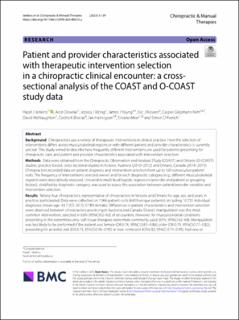| dc.description.abstract | Background
Chiropractors use a variety of therapeutic interventions in clinical practice. How the selection of interventions differs across musculoskeletal regions or with different patient and provider characteristics is currently unclear. This study aimed to describe how frequently different interventions are used for patients presenting for chiropractic care, and patient and provider characteristics associated with intervention selection.
Methods
Data were obtained from the Chiropractic Observation and Analysis STudy (COAST) and Ontario (O-COAST) studies: practice-based, cross-sectional studies in Victoria, Australia (2010–2012) and Ontario, Canada (2014–2015). Chiropractors recorded data on patient diagnosis and intervention selection from up to 100 consecutive patient visits. The frequency of interventions selected overall and for each diagnostic category (e.g., different musculoskeletal regions) were descriptively analysed. Univariable multi-level logistic regression (provider and patient as grouping factors), stratified by diagnostic category, was used to assess the association between patient/provider variables and intervention selection.
Results
Ninety-four chiropractors, representative of chiropractors in Victoria and Ontario for age, sex, and years in practice, participated. Data were collected on 7,966 patient visits (6419 unique patients), including 10,731 individual diagnoses (mean age: 43.7 (SD: 20.7), 57.8% female). Differences in patient characteristics and intervention selection were observed between chiropractors practicing in Australia and Canada. Overall, manipulation was the most common intervention, selected in 63% (95%CI:62–63) of encounters. However, for musculoskeletal conditions presenting in the extremities only, soft tissue therapies were more commonly used (65%, 95%CI:62–68). Manipulation was less likely to be performed if the patient was female (OR:0.74, 95%CI:0.65–0.84), older (OR:0.79, 95%CI:0.77–0.82), presenting for an initial visit (OR:0.73, 95%CI:0.56–0.95) or new complaint (OR:0.82, 95%CI:0.71–0.95), had one or more comorbidities (OR:0.63, 95%CI:0.54–0.72), or was underweight (OR:0.47, 95%CI:0.35–0.63), or obese (OR:0.69, 95%CI:0.58–0.81). Chiropractors with more than five years clinical experience were less likely to provide advice/education (OR:0.37, 95%CI:0.16–0.87) and exercises (OR:0.17, 95%CI:0.06–0.44).
Conclusion
In more than 10,000 diagnostic encounters, manipulation was the most common therapeutic intervention for spine-related problems, whereas soft tissue therapies were more common for extremity problems. Different patient and provider characteristics were associated with intervention selection. These data may be used to support further research on appropriate selection of interventions for common musculoskeletal complaints. | en_US |

